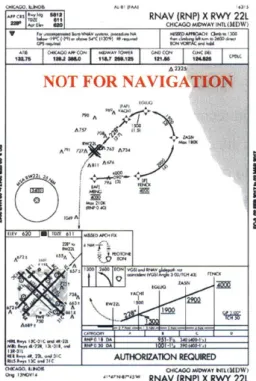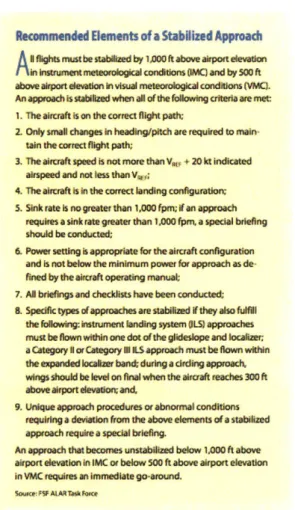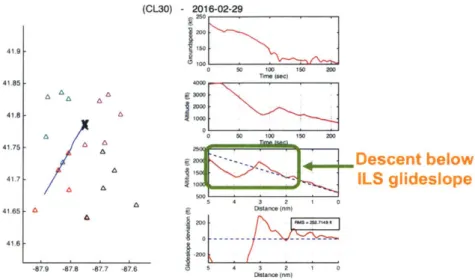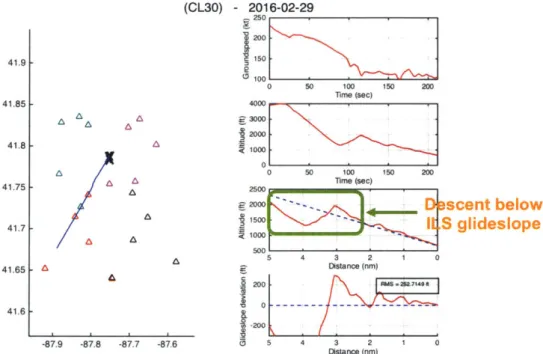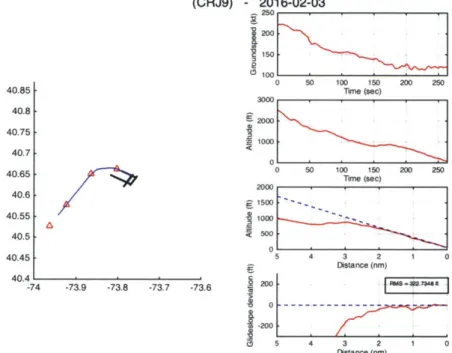Analysis of Approach Stability and Challenges in Operational
Implementation of RNP Approach Procedures
by
Sandro Salgueiro Rodrigues Filho
B.S.E. Aerospace Engineering - University of Michigan, 2015 Submitted to the Department of Aeronautics and Astronautics
in Partial Fulfillment of the Requirements for the Degrees of Master of Science in Aeronautics and Astronautics
at the
Massachusetts Institute of Technology
May2017 j
Z.Q, II
C 2017 Massachusetts Institute of Technology. All rights reserved.
Signature of
Author:-Certified by:
Accepted by:
Signature redacted
Department of Aeronautics and Astronautics, International Center for Air Transportation May 25, 2017
Signature redacted
R. John Hansman T. Wilson Professor of Aeronautics and Astronautics Thesis Supervisor
Signature redacted
t
Associate Professor of Aeronautics and Astronautics Chair, Graduate Program Committee, Department of Aeronautics and Astronautics
MASSACHUSETTS INSTITUTE
OF TECHNOLOGY
LJUL
112017
-73-Analysis of Approach Stability and Challenges in Operational
Implementation of RNP Approach Procedures
by
Sandro Salgueiro Rodrigues Filho
Submitted to the Department of Aeronautics and Astronautics 25 May 2017
In Partial Fulfillment of the Requirements for the Degree of
Master of Science in Aeronautics and Astronautics
Abstract
Required Navigation Performance (RNP) instrument procedures guarantee high levels of navigation precision through highly accurate navigation sources (e.g. GPS) and real-time monitoring of position estimation accuracy. In recent years, the Federal Aviation Administration (FAA) has developed and published public RNP approach procedures at airports across the country. These RNP procedures offer unique capabilities such as curved segments (radius-to-fix, or RF legs), narrow containment areas, and constant descent profiles that are not seen combined in other categories of instrument approaches. Because of these capabilities, RNP approaches are regarded as highly flexible procedures that can be designed to meet specific stakeholder requirements (e.g. lower minimums in mountainous areas, minimizing fuel bum during approach, avoiding flight over populated areas for noise abatement, etc.) at the airport level. Among the various proposed benefits of RNP approaches, this study analyzed potential safety benefits related to improvements in approach stability. In total, 11,062 individual approaches at four airports were analyzed using radar (ASDE-X) data, of which 364 (3.29%) were identified as RNP procedures. Of all approaches analyzed, two non-RNP cases were identified as unsafe, while there were no unsafe RNP cases. However, due to the relatively low number of RNP approaches observed, no statistically significant evidence of improved stability on RNP approaches was found. Given the low utilization of RNP approach procedures found from radar data, further work was done to identify barriers to operational use of these procedures and to investigate strategies to accelerate the adoption of RNP across the National Airspace System (NAS). Potential factors driving the low utilization of RNP procedures were found to be the low levels of equipage and operational approval among air carriers, and difficulties in air traffic management stemming from mixed equipage operations.
Thesis Supervisor: R. John Hansman
Acknowledgements
This work was sponsored by the Federal Aviation Administration (FAA). Opinions, interpretations, conclusions, and recommendations are those of the authors and are not necessarily endorsed by the United States Government.
Table of Contents
A BSTRA C T ... 3 A C K N O W LED G EM EN TS ... 4 TA BLE O F C O N TEN TS ... 5 LIST O F FIG U R E S... 7 1 IN TR O D U C TIO N ... 9 1.1 BACKGROUND... 91.2 A PPROACH STABILITY AND SAFETY... 10
1.3 W HY RN P APPROACHES MAY BE M ORE STABLE ... 12
2 A PPR O A C H A N D M ETH O DS... 18
2.1 O VERVIEW ... 18
2.2 THE AIRPORT SURFACE DETECTION EQUIPMENT MODEL X (ASDE-X)... 19
2.3 D ATA SAM PLE AND LIMITATIONS ... 20
3 RADAR (ASDE-X) ANALYSIS RESULTS... 22
3.1 U TILIZATION OF RN P PROCEDURES ... 22
3.2 A NOM ALOUS APPROACH CASES ... 23
3.3 G LIDEPATH TRACKING PERFORMANCE ... 25
3.4 D ISCUSSION OF APPROACHES ... 27
3.4.1 Approaches at Chicago M idway (KM D W)... 27
3.4.1.1 RN A V (RN P) X RW Y 22L ... 27 3.4.1.2 V isual A pproach RW Y 22L... 29 3.4.1.3 ILS RW Y 4R ... 31 3.4.1.4 A pproaches at N ew Y ork JFK (K JFK )... 34 3.4.1.5 V O R RW Y 13L ... 34 3.4.1.6 RN A V (RN P) RW Y 13L ... 36
3.4.2 Approaches at D enver (KDEN) ... 38
3.4.2.1 ILS A pproaches ... 39
3.4.2.2 RN A V (RN P) A pproaches... 39
3.4.3 Approaches at Seattle (KSEA)... 40
3.4.3.1 ILS A pproaches ... 41
3.4.3.2 RN A V (RN P) Z RW Y 16C/R ... 41
4 CHALLENGES IN OPERATIONAL IMPLEMENTATION OF RNP APPROACH PR O C ED U R ES... 43
4.1 BARRIERS TO O PERATIONAL U SE OF RN P ... 44
4.1.1 A TC barriers ... 44
4.1.2 Operator barriers ... 47
4.1.2.1 A ircraft qualification... 47
4.2 INITIATIVES To ACCELERATE THE OPERATIONAL ADOPTION OF RNP ... 50
4.2.1 Advanced RNP (A-RNP) ... 50
4.2.2 Time-based separation ... 52
4.3 SUCCESSFUL ATTEMPTS TO INCREASE THE UTILIZATION OF RNP ... 53
4.3.1 Ne w Yo r k JFK (, JFK ... 53
4.3.2 Chicago M idway (K A11D W) ... 55
4.3.3 D enver (KD EN) ... 56 5 CO N CLU SIO N ... 58 6 RE FEREN CES ... 60 APPEND IX A ... 61 APPEND IX B ... 62 APPEND IX C ... 63 APPEND IX D ... 64 APPEND IX E ... 65 APPEND IX F ... 66 APPEND IX G ... 67 APPEND IX H ... 68
List of Figures
Figure 1. A public RNP procedure at Chicago Midway (MDW). ... 10
Figure 2. Flight Safety Foundation's criteria for a stable approach... 12
Figure 3. The angular nature of the glideslope means that, for the same altitude deviation
from
the prescribed glidepath, the pilot sees a bigger angular deviation in his/her onboard tracking instrument the closer he/she is to the runway... 13 Figure 4. The dashed red lines indicate the accuracy limit of the RNP track. In the flight deck,
the pilot sees a constant sensitivity in the equipment displaying the vertical guidance... 13
Figure 5. Top: in an ILS approach, the aircraft must be on the final approach to receive course
guidance. Bottom: in an RNP approach, guidance is provided continuously, including in turns. 14
Figure 6. Top: lateral accuracy limits of an RNP approach. Bottom: vertical accuracy limits of
an RNP approach. A missed approach is required if the aircraft ever exceeds either limit. ... 15
Figure 7. VOR or GPS approach to runway 13L at JFK, which has a visual segment starting at
the DMHYL intersection. The procedure is popularly known as the "Canarsie" approach... 17
Figure 8. Airports analyzed were in the intersection of airports equipped with ASDE-X and
airports with RNP AR approach procedures. ... 20
Figure 9. A sample plot of ASDE-X datafor a single approachflown into Chicago Midway
(K M D W ) ... 2 0
Figure 10. An unsafe case in which a Boeing 767 flying the Canarsie approach starts a descent
from
the MDA while below the nominal 3-degree visual glidepath. ... 24Figure 11. An unsafe case in which a Challenger 300 flies the ILS approach to 4R and descends
below the glideslope while 4 m iles out. ... 25
Figure 12. Histograms of RMS (cumulative) glidepath deviation for aircraft flying RNP, ILS,
and visua l app roaches. ... 2 6 Figure 13. A representative case of an aircraft (a Boeing 737-700) flying the RNA V (RNP) X
R W Y 22L a t M D W ... 28
Figure 14. An outlier case showing a Boeing 737-700 leveling off monetarily at 1500 feet while
flying the RNA V (RNP) X R W Y 22L... 28
Figure 15. Representative cases of aircraft flying visual approaches to runway 22L on different
days. Notice the variability in lateral trajectories and vertical profiles... 30 Figure 16. An outlier case showing a Boeing 737-700 on a visual approach to runway 22L
clim bing during a turn to final... 31 Figure 17. A representative case of an aircraft (a Boeing 73 7-700) flying the ILS RWY 4R at
M D W ... 3 2
Figure 18. An unsafe case showing a Challenger 300 descending well below the glideslope while
4 m iles out on the ILSfor 4R. ... ... 33
Figure 19. A representative case of an aircraft flying the Canarsie approachfor runway 13L at
KJFK. Notice the level-off at the MDA of 800 feet ... 35
Figure 20. An unsafe case in which a Boeing 767 starts a descent
from
the MDA while below theg lid ep a th . ... 3 6
Figure 21. A representative case of an aircraft flying the RATP approachfor runway 13L at
KJFK. Notice the continuous descent
from
3000 feet... 37 Figure 22. An outlier case in which a ERJ 190 flying the RNP approach to 13L levels offFigure 23. A representative case of an aircraft flying an ILS approach at Denver... 39
Figure 24. Representative cases of RNP approaches at Denver... 40
Figure 25. A representative case of an aircraft flying an ILS approach at Seattle. ... 41
Figure 26. A representative case of an aircraft flying an RN approach at Seattle. ... 42
Figure 27. Barriers to operational implementation of RNP stem
from
challenges faced by individ ual stakeholders... 43Figure 28. Illustration of in-trail vectoring for parallel runway approaches... 44
Figure 29. Aircraft being vectored on approach to Chicago O'Hare (cyan). Source: F lig h tA w a re. ... 4 5 Figure 30. The RN? Z RWY 16R at KSEA (Seattle) prescribes a turn-to-final at a specific location along the "downwind leg" of the procedure (red circle). ... 46
Figure 31. Left: RNP approach. Right: ILS approach. Note the identical ground track... 49
Figure 32. Left: RNP procedure at KMDW. Right: RNP procedure at KDEN Both procedures have fuel burn benefits in comparison to other available instrument approaches and encourage th e use of R N P ... 5 0 Figure 33. ATC display showing TSASfeatures. On the left, a vertical timeline bar tells the terminal controller when aircraft are expected to arrive at a certain metering fix or position (in this case, the threshold of runway 25L at KPHX). Speed commands can be issued to aircraft in order to adjust their arrival times. Source: MITRE . ... 53
Figure 34. The "Canarsie " approach to runway 13L at JFK ... 54
Figure 35. RNP approaches to parallel runways at DEN... 56
Figure 36. Utilization rate of RNP approaches at Denver. Note the increase in utilization rate after the EOR waiver was adopted in March 2015. Source: FAA... 57
Figure B1. Sample plots showing Boeing 737-700 aircraft flying the RNA V (RNP) XRWY22L on d iff eren t d ay s... 62
Figure C1. Four different RNP approaches on the left and four different visual approaches on the right. All approaches flown to runway 22L at MDW... 63
Figure D1. Plots showing aircraft flying the ILSfor runway 4R at KMDW ... 64
Figure El. The Canarsie approach as flown by four additional aircraft ... 65
Figure Fl. The RNA V (RNP) RWY 13L approach as flown by four different aircraft... 66
Figure G1. Representative cases of ILS approaches at Denver... 67
1 Introduction
Required Navigation Performance (RNP) approach procedures offer performance benefits such as reduced fuel bum and shorter flight times. These benefits are enabled primarily by the use of more precise navigation technology that allows for the highly precise tracking of three-dimensional flight paths. This study was initiated with the goal of investigating potential safety benefits that were speculated to exist as a product of this increased navigation performance. Such a study was motivated by the hypothesis that, due to the fact that RNP approaches are required to be flown with an autopilot and have tighter navigation containment, aircraft flying these procedures may be more stable on their final approaches.
Following analysis of radar data that was used to investigate approach stability benefits, it was discovered that RNP utilization was remarkably low at the airports analyzed. This prompted further research into the barriers to operational use of RNP procedures and initiatives to accelerate their adoption across the National Airspace System (NAS).
This thesis introduces the methodology used to investigate approach stability benefits in RNP approaches, discusses results of radar data analysis, and investigates reasons for the observed low utilization of RNP approach procedures at four major airports in the United States.
1.1 Background
Required Navigation Performance (RNP) instrument procedures guarantee high levels of navigation precision through highly accurate navigation sources (e.g. GPS) and real-time monitoring of position estimation accuracy. First used by Alaska Airlines in 1996, RNP approaches were originally designed to improve access to airports located in mountainous regions during times of instrument meteorological conditions. Due to the availability of curved segments (Radius-to-Fix, or RF legs), RNP approaches were found to offer relatively high design flexibility, with the potential of also being used in areas of non-challenging terrain to meet specific local stakeholder requirements. In recent years, the Federal Aviation Administration
(FAA) has developed and published several RNP AR (Authorization Required) approach
procedures at airports across the country (Figure 1). Many of these new procedures offer lower fuel bum to operators by making use of RF legs to reduce path length as well as constant descent profiles.
."c.1=484.11 RAV RNP) X RWY 22L
NOT FOR NAVIGATION
r- A UTOIAINRQIE
A W 15
" RNA 2L
Figure 1. A public RNP procedure at Chicago Midway (MDW).
Because RNP AR approaches offer reduced lateral obstacle evaluation areas that are predicated on specific aircraft and aircrew performance requirements, they require special authorization similar to Category II and Category III ILS approaches. At the time of writing of this thesis, all RNP approaches (393) published in the United States were of the AR type. Among the potential benefits of RNP approaches, this study analyzed potential safety benefits that are directly connected to approach stability.
1.2 Approach Stability and Safety
In its 2010-2014 accident report, the International Air Transport Association (IATA) showed that runway excursions today represent the largest source of accidents in commercial aviation, and the third largest source of fatal accidents (90 accidents and 174 fatalities between 2010 and 2014). The Flight Safety Foundation has identified that many of these excursions are the result of unstable approaches where the aircraft was not in proper landing configuration prior to touchdown. Two of the most common elements that appear in runway excursion events are: 1) aircraft too fast on final approach, and/or 2) aircraft too high on final approach. Therefore,
runway excursions during landing can often be traced back to high energy states in the approach phase.
The occurrence of a second category of accident, Controlled Flight Into Terrain (CFIT), is also seen to correlate with unstable approaches. A CFIT event is one where a fully functioning aircraft is inadvertently flown into the ground by the crew, often due to spatial disorientation during an instrument approach. Because CFIT during an instrument approach is more likely to occur when the aircraft is low and close to the ground, approaches in which the aircraft is found to be significantly below the nominal glidepath present increased risk.
Finally, another category of accidents, Loss of Control (LOC) on approach, can be correlated with aircraft being in a lower-than-normal energy state during final approach (i.e. low airspeed and/or altitude), a scenario that can evolve into an aerodynamic stall and lead to loss of aircraft controllability.
Given the various deviations in aircraft states discussed above that could lead to an increase in risk, the commercial aviation industry takes a methodical approach to preventing unstable approaches by training crews to identify an unstable approach according to formal criteria. Perhaps the most widely recognized set of criteria defining a stable approach is the one published
Iecommended Eementsofa Stablund Approach
A
11Ights in instruuMen must be stabilied nk oogicaI by L0 taoearoteeeoconditions (NMO and by SW0 ftbe airport elevation in visual meteorologcal conditions (VMQ. Anapproachis blaed when al ofthe fallowing clteda are met:
1. The arcraftis on the correct flight path;
2. Only small changes In heading/pitch are required to main-tain the correct Right path;
3. The arcraft speed Is not more than Vf+20 kt indicated
airspeed and not less than Vw;
4. The acraft is in the correct landing configuration;
5. Sinkratels no greater than 1 000 fpm; if an approach requires asink rate greater than 1000 fpm, a special briefing should be conducted
6. Power setting is appropriate for theacraft conefguration and is not below the minimum power for approach as de-fined by theaircraft operatng manuat
7. All briefngs and checdists have been conducted;
.Spedfc types ofapproaches are stabliaed If they also fulfll the following: Instrumentlanding system "LS) approaches must beflownwithinone dot ofthe gldeslopeandlocaier;
aCategy I or Category iLSapproach must be flown within
the expandedlocalser bandt during a cclngapproahi
wings should be level on final when the arcraf reaches 300 ft aboveairportdeavadonand
9. Unique approach procedures or abnormal conditions requiringa deviation frnm the above elements ofa stabilind approach requirea special briefng.
An approach that becomes unstabilized below 1000 ft above airport elevation in IMC or below 500 ft above airport elevation
in VMC requires an Immediate go-around.
So&We;FVAasTrkft"e
Figure 2. Flight Safety Foundation's criteria for a stable approach.
The stability of an approach can be affected by various factors, such as the availability of onboard vertical guidance and the type of vertical profile being flown (e.g. step-down descent vs. continuous descent). The Flight Safety Foundation has proposed that unstable approaches are often caused by flight-handling difficulties that arise from rushed approaches, attempts to comply with demanding ATC clearances, adverse wind conditions, and improper use of automation.
1.3 Why RNP approaches may be more stable
Today, the ILS approach is the standard precision approach utilized in all major airports in the United States. ILS provides both lateral and vertical guidance along the final approach path
provide a straight final approach segment that is tracked for about five nautical miles prior to
touchdown. Also noteworthy is the fact that the localizer and the glideslope signals are angular,
and change in width as the aircraft approaches the runway. This, in turn, causes the onboard
guidance equipment to have variable sensitivity and requires variable control gains from the pilot
or autoflight system. Figure 3 below illustrates the angular nature of the glideslope beam, which
guides the aircraft along a prescribed glidepath.
Ed ge of iLs 0.7o
gldeslope
0.70
Figure 3. The angular nature of the glideslope means that, for the same altitude deviation from
the prescribed glidepath, the pilot sees a bigger angular deviation in his/her onboard tracking
instrument the closer he/she is to the runway.
In an RNP approach, the lateral and vertical guidance is instead computed by the aircraft
Flight Management System (FMS), which usually relies on GPS and inertial reference sensors
for lateral navigation and barometric data for vertical navigation (baro-VNAV). Since the lateral
and vertical guidance do not not rely on physical ground infrastructure such as in an ILS, the
guidance can be provided to the pilot in a linear fashion (as opposed to angular).
RNP vertical -
-0-
150
fttrack
limits-Figure 4. The dashed red lines indicate the accuracy limit of the RNP track. In the flight deck,
RNP approaches differ from ILS approaches in another key way. To begin an ILS approach, aircraft are usually vectored out of their arrival routes and towards an ILS intercept point. During the period when the aircraft is being vectored, no onboard path guidance exists since the aircraft is not following a predetermined trajectory. The crew must therefore make use of tools such as moving maps and approach plates to build a mental picture of the aircraft's motion and position to maintain situation awareness. Because an RNP approach is, on the other hand, commonly initiated at a GPS waypoint that coincides with a waypoint that is also part of an arrival route, vectoring is not required and the aircraft is able to continuously follow a predetermined path all the way to touchdown. The ability to fly this preconceived RNAV path provides continuous lateral and vertical guidance to the crew during the arrival and approach phases of flight, with no changes in situation awareness. Figure 5 illustrates the situation described above.
- 2.50 No course guidance untl established an final approach 2*RNP fRNP S 0.3 nm)
Figure 5. Top: in an ILS approach, the aircraft must be on the final approach to receive course guidance. Bottom: in an RNP approach, guidance is provided continuously, including in turns.
In order to be approved to fly RNP approaches, an operator is required to implement specific operational mitigation practices. For a flight crew, this comes in the form of additional training. During an RNP approach, the crew has the additional task of monitoring the aircraft navigation system performance in real-time, as well as taking appropriate action if navigation accuracy or path tracking becomes compromised. In the United States, the FAA maintains that all deviations from the assigned path during an RNP approach be kept within Ix RNP laterally and within 75 feet vertically. If either of these values is exceeded at any point in the approach, a missed approach must be initiated (Figure 6). Because of this requirement, along with the fact that RNP approaches are captured "earlier" than ILS approaches and connect directly with arrival routes, it is hypothesized that a crew flying an RNP approach will generally be more aware of path deviations and have improved situational awareness.
.j2*RNP A
(RNP S 0.3 nm)
- - 150 ft
Figure 6. Top: lateral accuracy limits of an RNP approach. Bottom: vertical accuracy limits of
an RNP approach. A missed approach is required if the aircraft ever exceeds either limit.
Finally, because the aircraft itself also needs specific approval to fly RNP AR procedures, aircraft manufacturers will normally engage in flight trials to demonstrate a specific aircraft's ability to maintain a specified navigation accuracy level (i.e. RNP value) [2]. Because all errors (navigation system error, path definition error, and flight technical error) are taken into account when an aircraft is being certified for its lowest possible RNP, these flight trials are often performed with the autopilot engaged during the approach in order to minimize flight technical
error (FTE). As a result, if the demonstration is done using the autopilot only, all subsequent operations of that aircraft in environments requiring the same RNP value must be performed with the autopilot engaged. Typically, aircraft are certified to be flown with either the autopilot or the flight director when the RNP is 0.3 or greater. For RNP values lower than 0.3, the autopilot is generally required to be engaged during the approach. As a result of this requirement, it is expected that aircraft flying RNP approaches to show more consistent and precise tracking of the approach course due to the use of automation.
Because of the unique characteristics of RNP approaches mentioned above, three hypotheses for how RNP approaches could contribute to more stable approaches and therefore higher levels of safety were raised:
1. The required use of automation minimizes flight technical error (FTE), minimizes
crew workload, and puts the crew in a monitoring role where more time can be invested in managing situational awareness. The additional requirement to monitor the aircraft navigation performance in real time as part of the operational mitigation aspect of RNP AR further brings situational awareness into focus.
2. When RF legs are used, aircraft are established on procedure profile before turning to final. It is hypothesized that an early "capture" of the profile could translate into a more stable final approach. In the procedure shown in Figure 1, the aircraft will typically be established in the lateral and vertical profile of procedure at the MIING waypoint.
3. When no instrument procedure offering digital vertical guidance is available for a
given runway, an RNP approach can yield a more stable descent by providing onboard vertical guidance. It is hypothesized that approaches to runways that commonly rely on visual segments (e.g. JFK 13L) could benefit from the added vertical guidance that RNP offers. Figure 7 below shows the popular Canarsie approach to JFK 13L, which has a visual segment starting at the DMYHL position. An RNP approach that mimics the visual segment of the Canarsie was developed and
-'-. "31 VOR or GPS RWY 13L/ 131
"L 0
'I
&*=YMAF
701
6-AIIO -p 6o-1 moad b ,* .
602 VPi I7: FrnV2F
AMfI~ 6002XY CON~2 1 M~~1U
Pw - I bAMW3w1 MMe *15
^14 19D 21AOI16 4'7V VOR or GPS RWY 1 3L/1 3ROR F GPSWY MUM/1R
I
I
UI
I UI
Figure 7. VOR or GPS approach to runway 13L at JFK, which has a visual segment starting at the DMHYL intersection. The procedure is popularly known as the "Canarsie" approach.
The initial goal of this study was therefore to investigate the stability of RNP approaches flown across the National Airspace System (NAS) and establish a comparison between the stability of flown RNP procedures and that of other types of procedures. The main questions being asked were:
1. Do RNP approaches show benefits in approach stability or safety in general?
2. If yes, can the safety benefit be quantified?
-VW1, WNW VM M,6 10 pmA ,62M
R
2 Approach and Methods
2.1 Overview
In order to analyze the stability of approaches, high resolution radar data that included aircraft altitude, speed and position data was required. By plotting an aircraft's descent profile (i.e. altitude vs. distance from runway), glidepath tracking was to be evaluated for the purpose of analyzing approach stability. After experimenting with both terminal radar (PDARS) data and
ASDE-X data, it was determined that ASDE-X was the better data source as it had a higher
update rate on final approach because of the additional ground multilateration (MLAT) sensors available to the ASDE-X system. While terminal radar provided updates every -4.5 seconds,
ASDE-X was able to update the data up to once per second.
In an initial analysis, dates of radar data for four airports with RNP approaches (KJFK, KMDW, KDEN, KSEA) were randomly selected. During this first round of data analysis, 7,640 approaches were analyzed, with only 64 (0.84%) of them being identified as RNP procedures. As a result of the small number of RNP procedures identified, a new strategy to choose specific dates on which operators were most likely to fly RNP procedures at the specified airports was developed to increase the number of RNP samples. This was done by using the website FlightAware to search for dates when a runway with a published RNP procedure was being used at a given airport, and finally selecting dates from that subset in which at least one RNP procedure was observed to be flown in the FlightAware tracking data. At the end of a second round of data analysis using the new selected dates, 11,062 approaches had been analyzed and a total of 364 RNP approaches (3.29%) identified. It is important to point out that the 0.84% RNP utilization found in the first round is likely representative of the average RNP utilization at the four specified airports, while the 3.29% value is biased by the fact that it was obtained with data from days when RNP procedures were known to be used.
Using the ASDE-X data, each arriving aircraft's trajectory, speed, and altitude were plotted. Each plot generated was then individually reviewed for any anomalies that may represent an increase in risk (e.g. significant deviations from approach glidepath). Each approach analyzed was labeled as either representative (normal), outlier, or unsafe. Each approach received its designation following an analysis of glidepath tracking performance under the following criteria:
e If glidepath tracking showed excursions exceeding 1 dot of glidepath deviation (> 0.35
degrees) below 500 ft AGL, or if at the initiation of an instrument approach the aircraft failed to capture the proper glidepath, the approach was labeled as unsafe.
- If glidepath tracking showed excursions exceeding 1 dot of glidepath deviation (> 0.35
degrees) between 1000 ft AGL and 500 ft AGL that were corrected before the aircraft reached 500 ft AGL, the approach was labeled as an outlier.
* If none of the criteria above were met, the approach was labeled as representative (i.e.
normal).
The flagging of outlier and unsafe cases was assisted by algorithms that searched for significant deviations in approach profiles, such as an aircraft being well below glideslope in an
ILS approach. The results of this analysis provide the basis for the discussion presented in Section 3 of this thesis.
2.2
The Airport Surface Detection Equipment Model X (ASDE-X)
The ASDE-X system is available at 36 major U.S. airports and is used to track aircraft movement on both airport surfaces and in the air within a 10-nautical-mile radius of the airport control tower. ASDE-X is an integrated surveillance system that fuses data from primary radar, secondary radar, surface movement radars, and ADS-B [3].
In the United States, the FAA collects and stores ASDE-X data from all of its major sites and makes the data available upon request. This data was the basis for the analysis performed in this work. The data that was obtained covered the period from April 2015 to April 2016, as well as a few days from 2013 and 2014. Airports that were chosen for the analysis were selected based on the availability of ASDE-X data and published RNP AR procedures. Based on the intersection of these two sets, the airports selected for the analysis were Chicago Midway (KMDW), New York JFK (KJFK), Denver (KDEN), and Seattle (KSEA). These four airports were selected from the intersection subset based on the availability of curved RNP approach procedures that would be easy to detect from trajectory data, as well as prior knowledge of operators flying RNP procedures at these locations.
Airports with Airports with
RNP procedures ASDE-X(36)
Airports available for analysis
(29)
Figure 8. Airports analyzed were in the intersection of airports equipped with ASDE-X and
airports with RNP AR approach procedures.
2.3 Data Sample and Limitations
A sample from the ASDE-X data is shown in Figure 9 and further explained below. This
sample shows the profile flown by an aircraft flying the RNAV (RNP) X RWY 22L at Chicago Midway (KMDW). Aicraft 7 !Fr~a(13738) 42.1 42 41.9 Lateral trajectory 417 41.6 41.5 41.4 I Type IW
-"o 7 ..
Groundspeed :10001(kt) 0 50 100 1W0 2W 2W0 3W0 3W Tbm 0.c) 40 00 Altitude am. (ft) 0 so 100 110 we 300 30 Ao Vertical SOOA 5- profile & 1000 (ft vs. nm) - 0 5 4 3 2 1 0 -20I '"-- '" " Glidepath S4- deviation 200 2(ft) -87.9 47.8 -87.7 47.6 5 4 3 Duane* (.iniFigure 9. A sample plot of ASDE-X data for a single approach flown into Chicago Midway (KMDW).
e Lateral trajectory: This box shows a top-down view of the aircraft as-flown lateral
trajectory. The colored triangles indicate waypoints from RNP approach procedures available at the airport, and each color represents a different procedure. Runways are
illustrated as solid black rectangles.
e Groundspeed: This box shows the aircraft groundspeed in knots as a function of time.
The plot starts (t = 0) at the first available data point, and ends when the aircraft crosses the runway threshold.
e Altitude. This box shows the aircraft altitude above mean sea level in feet as a function of
time. The plot starts (t = 0) at the first available data point, and ends when the aircraft
crosses the runway threshold.
* Vertical Profile. This box shows the aircraft altitude above mean sea level in feet as a function of along-path distance from the runway threshold (in nautical miles). The blue dashed line indicates a reference 3-degree glidepath. The plot starts when the aircraft is 5 nautical miles away from the runway threshold on approach, and ends when the aircraft crosses the threshold.
e Glidepath Deviation. This box shows the deviation in feet from the reference 3-degree
glidepath shown in the Vertical Profile box. The plotted values are calculated as the difference between the aircraft actual altitude and the reference glidepath altitude at a given distance from the runway threshold. A box in the upper right corner of this window shows the cumulative root mean square (RMS) deviation.
Each approach analyzed was labeled as either representative, outlier, or unsafe. Each approach received its designation following an analysis of glidepath tracking performance. If glidepath tracking was considered normal throughout the entire descent, the approach was labeled as representative. If glidepath tracking showed momentary excursions that were not considered dangerous, the approach was labeled as an outlier. Finally, if glidepath tracking showed excursions that were considered dangerous, the approach was labeled as unsafe.
In this study, groundspeed was not used as a parameter to gauge the stability of an approach. There were two reasons for this decision: 1) the groundspeed in the ASDE-X data is derived from the rate of change of position, and can be noisy at times. In fact, the ASDE-X system requirement for groundspeed accuracy is only 20 knots; 2) the groundspeed does not directly reflect the energy state of the aircraft, which is instead dictated by airspeed. Because no high-resolution data on wind speed and direction was available, it was not possible to accurately calculate airspeed from groundspeed. Therefore, although it is recognized that a stable airspeed on final approach is an important characteristic of a stable approach, this study limits its analysis of approach stability to the inspection of altitude data (i.e. vertical profile). For any future studies that necessitate reliable airspeed numbers, data from aircraft quick access recorders (QAR) or flight data recorders (FDR) would need to be obtained.
3 Radar (ASDE-X) Analysis Results
3.1 Utilization of RNP procedures
In total, 11,062 individual approaches were analyzed, of which 364 (3.29%) were identified as RNP procedures. It is important to point out that the 0.84% RNP utilization found in the first round is more representative of the average RNP utilization at the four specified airports, while the 3.29% value is biased by the fact that it was obtained with data from days when RNP procedures were known to be used. The dates analyzed for each airport are shown in Appendix
A. Among the 10,698 non-RNP approaches, two unsafe cases were identified, while none was
found among the 364 RNP approaches. Despite the fact that unsafe cases were only seen among non-RNP approaches, the results may be skewed by the much larger number of non-RNP samples. Therefore, a statistically significant safety benefit could not be claimed for RNP approaches. If an equivalent number of 10,000 RNP approaches were to be analyzed, approximately 300,000 approaches would have to be analyzed in total when a 3% utilization rate of RNP procedures is considered.
Different airports were seen to have different utilization levels of RNP procedures, with New York JFK having the highest utilization (7.56%) on the days that were analyzed, and Seattle having the lowest (0.30%). The RNP utilization level was found to be strongly correlated with the level of RNP equipage of the fleet operating at each airport, with a higher RNP equipage rate yielding higher utilization. At JFK, JetBlue is responsible for the majority of RNP procedures flown into runway 13L, and the airline's entire fleet is approved for RNP approaches. At MDW, Southwest drives the utilization of RNP procedures by making use of the RNP to runway 22L, a runway with no ILS approach. In the Southwest fleet, all 737NG aircraft are approved for RNP approaches. The overall breakdown of RNP utilization by airport is shown in Table 1.
Airport # of RNP appr. # of appr. (total) RNP percentage
KJFK 203 2684 7.56%
KMEDW 117 1725 6.78%
KDEN 39 5003 0.78%
KSEA 5 1650 0.30%
Table 1. Breakdown of RNP procedures usage by airport.
The low utilization levels come in spite of the fact that, according to the FAA, 62% of all Part 121 aircraft currently in service are equipped for RNP AR operations. It is important to point out, however, that only half of the RNP-equipped fleet (35% of the Part 121 fleet) have sought approval for operational use of RNP AR approaches [4]. Operators that were observed to be flying RNP procedures on the days that were analyzed are shown in Table 2 below.
Airport Carriers observed flying RNP procedures
KMDW Southwest
KJFK JetBlue, American, Delta, Cathay Pacific
KDEN Frontier, Southwest, United, Alaska
KSEA Alaska
Table 2. Breakdown of carriers observed to be flying RNP procedures.
3.2 Anomalous approach cases
Each approach analyzed was labeled as either representative (normal), outlier, or unsafe. Each approach received its designation following an analysis of glidepath tracking performance under the following criteria:
* If glidepath tracking showed excursions exceeding 1 dot of glidepath deviation (> 0.35
degrees) below 500 ft AGL, or if at the initiation of an instrument approach the aircraft failed to capture the proper glidepath, the approach was labeled as unsafe.
e If glidepath tracking showed excursions exceeding 1 dot of glidepath deviation (> 0.35
degrees) between 1000 ft AGL and 500 ft AGL that were corrected before the aircraft reached 500 ft AGL, the approach was labeled as an outlier.
e If none of the criteria above were met, the approach was labeled as representative (i.e.
normal).
Among the 11,062 approaches analyzed, 2 were identified as unsafe, and 3 were identified as outliers. The first unsafe case was a descent below glidepath during the visual segment of the VOR RWY 13L at JFK (Canarsie approach), shown below in Figure 10.
(B763) -_2016-02-03 40108 40.75
j1O(SC
40.7 40.65 0 0 5 0 0 40.6Tw0 2000- ' 40.56o 40.5 40.45 00gonc (om 40.414
( 5 4 3 2 1 0 Dstance (om)Descent below
visual glidepath
Figure 10. An unsafe case in which a Boeing 767 flying the Canarsie approach starts a descent
from the MDA while below the nominal 3-degree visual glidepath.
The second unsafe approach case observed was that of a Challenger 300 flying the ILS RWY 4R at MDW. In the approach, the aircraft descended 600 feet below the glideslope before starting a climb to re-intercept the glideslope (Figure 11).
(CL30) - 2016-02-29 25* 41.9 IS 00 0 so 100 150 am0 Tlfm (sec) 41.85 4MC - -Descent
below
41.7 1000 A5 4 3 2 1 0 41.65 A6 5~aroe
(nm) 41.6 0 ... -87.9 -87.8 -87.7 -87.6 5 4 3 2 Mamb. (Sm)Figure 11. An unsafe case in which a Challenger 300 flies the ILS approach to 4R and descends
below the glideslope while 4 miles out.
It is noted that both of the unsafe cases reported above were non-RNP approaches, which
might suggest a safety improvement in RNP approaches. However, it is important to note that,
because of the very different sample sizes (10,698 non-RNP approaches vs. 364 RNP
approaches) caused by the low utilization of RNP procedures, statistical significance to support
this conclusion was not reached.
Among the three outlier cases, which displayed momentary glidepath deviations with no
safety impact, there were two RNP approaches and one visual approach. The two RNP
deviations consisted of level-offs observed during the RNP procedure descent, which is designed
as a continuous descent profile with no level-offs. These are hypothesized to have occurred due
to mismanagement of autopilot descent modes. The final outlier case was identified in a visual
approach, in which the aircraft experienced an altitude gain of 300 feet during its base-to-final
turn. Outlier cases are discussed further in subsequent sections.
3.3 Glidepath tracking performance
A comparative analysis of representative (normal) cases of RNP, ILS, and visual approaches
was performed by comparing the RMS value of glidepath deviation on final approach of 60
randomly selected approaches of each type (the anomalous cases mentioned previously were
excluded from this analysis). This metric, which was calculated for each of the 180 approaches,
indicates the cumulative deviation from an ideal 3-degree glidepath on final approach for an individual aircraft. A histogram of the results is shown in Figure 12.
RNP ILS Visual
30 30 1 30
Mean: 36 ft Mean: 51 ft Mean: 73 ft
Std Dev: 14 ft Std Dev: 20 ft Std Dev: 58 ft
25 - - 25- - 25-20- - 20- - 20-Ch 15- - 15- - 15-10 - - 10 - - 10 -5 - 5 - 5 -0 11 0 0 50 100 150 200 0 50 100 150 200 0 50 100 150 200
RMS of Glidepath Deviation on Final Approach (last 5 nm)
Figure 12. Histograms of RMS (cumulative) glidepath deviation for aircraft flying RNP, ILS, and visual approaches.
RNP approaches had a mean RMS deviation of 36 ft, while the same metric was 51 ft for
ILS approaches and 73 ft for visual approaches. This is consistent with the hypothesis of
enhanced stability in RNP approaches. Only RNP approaches are required to be flown with an autopilot (i.e. coupled), whereas ILS approaches can either be flown with an autopilot or hand-flown, and all visual approaches are hand-flown. Therefore, the differences in glidepath deviation found for the three different approach types provide an indication of typical Flight Technical Error (FTE) values for coupled (flown with autopilot) and uncoupled (hand-flown) approaches. RNP approaches also had the lowest standard deviation from the mean, confirming the expectation of highly repeatable profiles with consistently small deviations.
A detailed discussion of the data analyzed at the four selected airports (KMDW, KJFK, KDEN, KSEA), as well as outlier and unsafe cases is given in subsequent subsections.
3.4 Discussion of approaches
This section presents a discussion of the stability of various approach procedures identified at the four selected airports. For each approach type being discussed, sample plots of representative approaches are shown, as well as any outlier and unsafe cases.
3.4.1
Approaches at Chicago Midway (KMDW)
As summarized in Table 1, a total of 1725 approaches were analyzed, where 117 of these were identified as RNP AR approaches (6.78%). The higher than average use of RNP AR approaches at MDW can be attributed to the use of the RNAV (RNP) X procedure for runway 22L. This is in part due to the fact that runway 22L has no ILS and because MDW is predominantly used by Southwest Airlines, which has all of its Boeing 737NG fleet equipped for RNP AR approaches. When runway 22L is used for arrivals, non-RNP aircraft are usually vectored for either a visual approach or for the RNAV (GPS) Z RWY 22L.
Among the 1725 approaches reviewed at MDW, one was identified as unsafe, and two were identified as outliers. The following subsections discuss the stability of aircraft flying specific approach procedures at KMDW.
3.4.1.1 RNAV(RNP)XRWY22L
Aircraft flying this approach predominantly showed very precise tracking of the approach profile. The approach is easily recognizable by the use of RF legs (constant-radius turns) and the constant descent from 4000' along a 3-degree glidepath. In the approximately 100 RNP approaches to runway 22L observed, overall approach stability was excellent. A representative case is illustrated in Figure 13. Additional plots of aircraft flying this approach can be found in
Appendix B. As can be seen, the lateral tracks and vertical profiles show very high repeatability
(B737) - 2016-01-30 300 250 42.1 -2j 150 42 0 50 100 150 200 250 300 350 4 -m e (s e c ) 41.9
~4000
41.8 0 50 100 150 200 20 300 350 Dnime (sc) A 2500 41.7 E 2000 A -41.8 - -O 5 4 3 2 1 0 A Distance (nm) 41.5 20 OS L76t 41.4 1-2D0 -87.9 -87.8 -87.7 -87.6 ( 5 4 3 2 1 0 Distance (no,)Figure 13. A representative case of an aircraft (a Boeing 737-700) flying the RNAV (RNP) X RWY 22L at MDW.
In the outlier case displayed below, a Boeing 737-700 flying the same procedure had its descent interrupted at 1500' at the final approach fix. The approach was labeled an outlier due to the aircraft being more than "one dot" away from glidepath at 1000 ft AGL.
(B737) - 2016-01-05 300 . . 42.1 2D0 150 2 100 42 0 50 100 150 200 250 300 30 lime (sec) 000 41.9 -0= 2000 41.8 00 50 100 150 300 250 300 350 4f ime (sec) A 2500 41.7 -Momentary level-off 41.6 Soo 5 4 3 2 1 0 Dstance (nm) 41.5 - -41.4 - - O -87.9 -87.8 -87.7 -87.6 5 5 4 3 2 m 0 Distance (Sm)
Figure 14. An outlier case showing a Boeing 737-700 leveling off monetarily at 1500 feet while flying the RNAV (RNP) X RWY 22L.
A hypothesis explaining the momentary level-off at 1500' is that the altitude selector in the
Mode Control Panel (MCP), which gives inputs to the autoflight system, was set to 1500' (the altitude constraint at the final approach fix) early in the approach, and not changed to the procedure MDA as the aircraft approached the final approach fix. In this case, due to the nature of the VNAV mode used for an RNP approach in the Boeing 737NG, the aircraft would have leveled off at the MCP altitude of 1500' instead of continuing its descent along the computed
VNAV path. In this case, the VNAV mode, which is used to guide the aircraft along the vertical
profile of an RNP procedure, acts differently from the APPR (approach) autoflight mode used in
ILS approaches in the 737, which are more commonly flown by crews.
While on an ILS approach with the APPR mode engaged instead, the autoflight system ignores any altitude selected in the MCP, and continues to descend along the glideslope regardless of whether MCP-selected altitudes have been reached. This difference in how the APPR and VNAV modes treat vertical navigation on an instrument approach might create room for confusion, as a crew may inadvertently apply their mental model of the APPR mode when flying RNP approaches with the VNAV mode instead. In such an event, crews might be faced with unexpected level-offs as the aircraft reaches altitudes that had been previously entered in the MCP altitude selector. Such a level-off would be consistent with that observed in Figure 14.
3.4.1.2 Visual Approach RWY 22L
Visual approaches to runway 22L were very common on the days that were analyzed. Because the only other instrument approach to runway 22L besides the RNP approach is the RNAV (GPS) Z, it is easy to identify a visual approach by observing the length of the final approach segment (the RNAV GPS approach requires a minimum final approach segment of 5.5 nautical miles, whereas aircraft flying a visual approach will usually fly a base leg well within a 5-mile radius of the airport). The RNAV GPS final approach segment is also offset from the runway extended centerline by 10 degrees, which further helps with differentiating approach types.
47. 42 41.9 41.5 -41.4 4p, Figure 15. Represe (E170) - 2016-01-06 (0737) - 2016-01-06 41. 41.4 (B737) -2016-1-30 (6737) -2016-02-29 47.6 -7.7 -76 -6 - - 476 476 477 .76
ntative cases of aircraft flying visual approaches to runway 22L on different days. Notice the variability in lateral trajectories and vertical profiles.
As can be seen in Figure 15, visual approaches do not show the same consistency and repeatability of flight trajectories as RNP approaches due to the use of ATC vectors. In most cases, they also include step-down descents instead of a continuous 3-degree descent as seen in the RNP case. Tracking of a 3-degree glidepath on final approach was observed to be good, albeit generally less precise than the tracking observed in RNP approaches, as expected. A side-by-side comparison of trajectories flown by aircraft in RNP and visual approaches is shown in
Appendix C. Among the set of visual approaches, the case shown in Figure 16 below was the
only outlier.
A At~ A A A A A A -87.9 -87.8 -87.7 -87 (B738) - 2016-01-30
~300
S150 2 100 0 1oo 200 300 400 Time (sec) 2000 0 0 100 200 300 400 Mfme (sec) 2500 1000base-to-final
500turn
5 4 3 2 1 0 - Distance (nm) 200 -1&4 0 .200 6 5 4 3 2 0 Distance (nm)Figure 16. An outlier case showing a Boeing 737-700 on a visual approach to runway 22L
climbing during a turn to final.
In this case, a Boeing 737-800 climbs about 300 feet during its base-to-final turn in a visual approach to runway 22L. It then proceeds to recapture the nominal 3-degree glidepath at a distance of 1 nautical mile from the runway threshold. The approach was labeled an outlier due to the aircraft being more than "one dot" away from glidepath at 1000 ft AGL. Due to the shallow rate of climb leading to the maximum glidepath deviation, the climb likely happened during a time when the aircraft was being hand-flown during its turn-to-final. The glidepath was recaptured within a mile of the runway threshold, and safety was not affected.
3.4.1.3 ILS RWY 4R
When the winds favor operations on runways 4L/R, the ILS for runway 4R is the approach of choice at MDW. Like RNP approaches, ILS offers onboard vertical guidance in the form of a glideslope. As discussed in Section 2, one key difference between RNP approaches and ILS approaches is that the latter usually requires the aircraft to be vectored to an intercept course from its original arrival path. RNP approaches, on the other hand, are usually connected to
42.1 42 41.9 -41.8 -41.7 41.6 -41.5 -41.4
arrival routes via waypoints, meaning there is continuous lateral and vertical guidance provided
by the flight management system (FMS).
The average ILS approach to runway 4R showed excellent tracking of the localizer and glideslope on final approach, as illustrated by the plot in Figure 17 below. Additional plots of aircraft flying this approach can be found in Appendix D.
42.1 -42 I 41.9 41.81 41.7 41.6 -A AA A A A A A A A 41.5 -41.4 Figure 17. A -87.9 -87.8 -87.7 -87 (B737) - 2016-03-01 200 1S0 2 0 50 100 150 200 ime (sec) 3000 2000 -1000 . 01 0 so 100 1so 2o0 ime (sec) 200 1500 4
~1000
500 5 4 3 2 1 0 Distance (nm) 20 6 a~ 5 4 3 2 1 0 Distance (nm)representative case of an aircraft (a Boeing 737-700) flying the ILS MDW.
RWY 4R at
One case that stood out from the rest, and which was flagged as unsafe, was an approach to 4R by a Challenger 300 followed by a side-step to runway 4L. In this approach, shown in Figure 18, the aircraft descends 600 feet below the glideslope before initiating a climb to recapture the 3-degree glidepath. The approach was labeled as unsafe due to the aircraft's failure to capture the proper instrument procedure glidepath upon initiation of the approach.
(CL30) - 2016-02-29 250 41.9 2 1001 0 50 100 1S0 200 Time (sec) 41.85 4000 41.8 1000-01 A0 50 100 150o 200 A A T~m(sec) 41.75 - 2 M nA60 Ec 2M)
13scent
below
41.7 -13gielp 5 4 3 2 1 0 whie5 e ostanne (hm) 41.6 - ---- ---87.9 -87.8 -87.7 -87.6 0 5 4 3 2 1 0 stanw (nm)Figure 18. An unsafe case showing a Challenger 300 descending well below the glideslope
while 4 miles out on the ILS for 4R.
The radar data alone gives us no explanation of what may have caused this event, but it is
hypothesized that the crew identified and corrected the error after receiving a "Glideslope"
warning from the aircraft's EGPWS. Such warning is triggered when, on an ILS approach, the
aircraft is 1.3 dots or greater below glideslope while below 1000 ft AGL. In this approach, the
aircraft is seen to start a climb back to glideslope when at approximately 800 ft AGL and 1
degree below glideslope (greater than 1.3 dots deviation). Therefore, the conditions for an
EGPWS "Glideslope" warning would have been met and an aural warning would have sounded
in the cockpit. Ultimately, this event portrays a case in which the availability of positive vertical
guidance (the glideslope) did not prevent a crew from losing situational awareness on approach.
If it is assumed that the aircraft was vectored to the ILS approach (as was most likely the
case), then the crew was likely given simple headings and altitudes to follow in order to intercept
the localizer and glideslope. In such scenario, no onboard guidance existed during the time the
airplane was being vectored, and the crew was responsible for transitioning to ILS guidance once
the proper signals (localizer and glideslope) were received. In an RNP approach, the crew would
have been provided continuous onboard guidance during the transition from the arrival
conclude whether the use of RNP could have prevented the deviation as it is impossible to determine the exact circumstances of this event from radar data alone.
3.4.1.4 Approaches at New York JFK (KJFK)
As summarized in Table 1, a total of 2684 approaches were analyzed at JFK, where 203 of these were identified as RNP AR approaches (7.56%). The higher than average use of RNP AR approaches at JFK can be attributed to the use of the RNAV (RNP) procedure for runway 13L. At JFK, the Canarsie approach (VOR RWY 13L) is used to deconflict traffic from LaGuardia and JFK and to provide noise abatement over populated areas. This procedure requires a visual turn at low altitude (-500 ft), and historically has been the primary procedure used at JFK when winds favor the use of runway 13L. Today, the RNP approach for 13L, which mimics the path of the Canarsie, has become the approach of choice for RNP-equipped carriers. Not only does it provide the ability of having the turn-to-final flown by the autopilot, but it also offers lower approach minimums than the VOR procedure (500 feet AGL versus 800 feet AGL). The high usage of this RNP procedure can be explained by two factors: first, the procedure's trajectory matches that of the alternative VOR procedure flown by non-RNP aircraft, which relieves the approach controller from dealing with mixed equipage. Second, carriers such as JetBlue have equipped their entire fleet for RNP AR approaches and can therefore be assigned the procedure
by ATC instead of having to make a request on a flight-by-flight basis. JetBlue claims that its
pilots used the RNP procedure 97.8% of the time in 2015 (equivalent to 5,939 RNP approaches) whenever runway 13L was the arrival runway [5].
Among the 2684 approaches reviewed at JFK, one was flagged as identified as unsafe, and one was identified as an outlier. The following subsections discuss the stability of aircraft flying specific approach procedures at KJFK.
3.4.1.5 VOR RWY 13L
The VOR approach to runway 13L at JFK, also known as the Canarsie approach, is a famous instrument approach requiring a 90-degree turn at low altitude during its visual segment. Although runway 13L is equipped with an ILS, the Canarsie approach helps deconflict traffic from JFK and LaGuardia (LGA) and therefore increases the capacity of the New York metroplex. It is therefore the preferred approach to runway 13L when ceiling and visibility allow.
